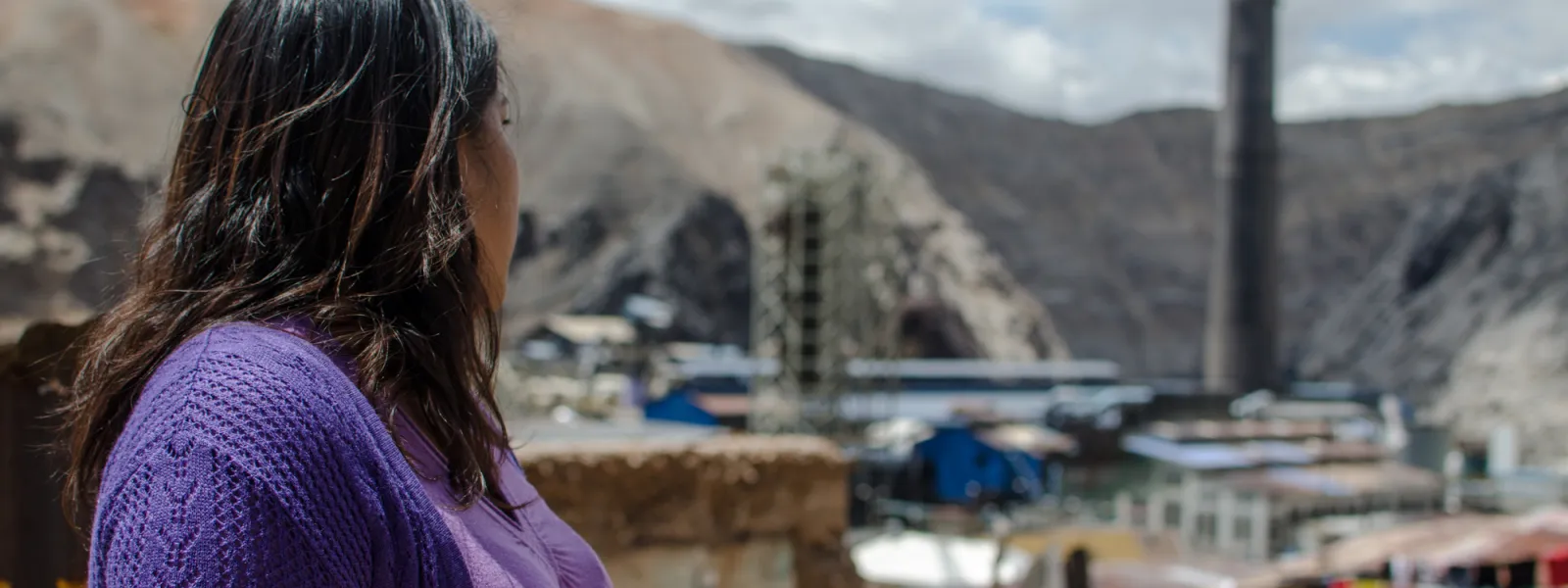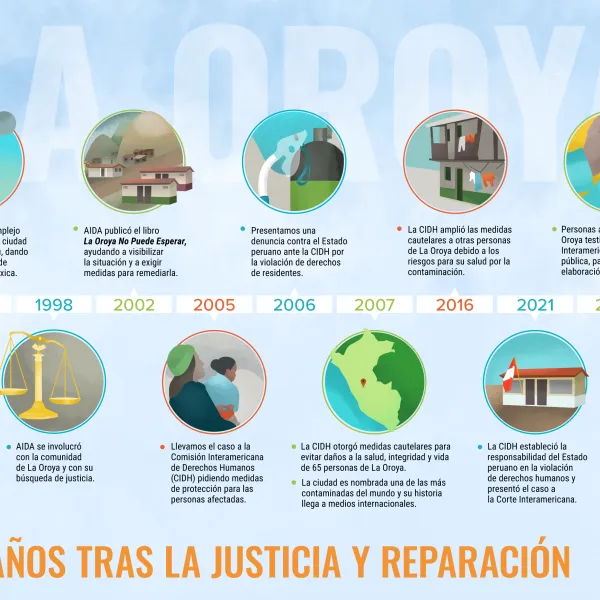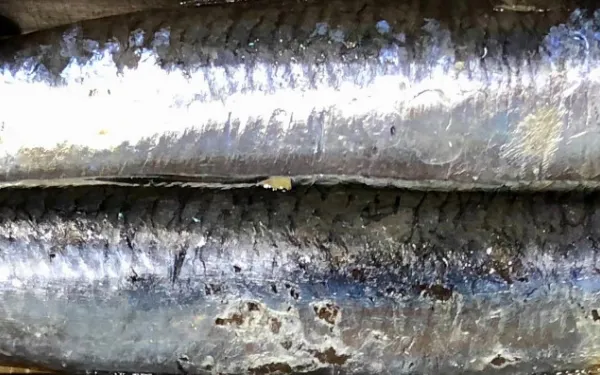
Project
Protecting the health of La Oroya's residents from toxic pollution
For more than 20 years, residents of La Oroya have been seeking justice and reparations after a metallurgical complex caused heavy metal pollution in their community—in violation of their fundamental rights—and the government failed to take adequate measures to protect them.
On March 22, 2024, the Inter-American Court of Human Rights issued its judgment in the case. It found Peru responsible and ordered it to adopt comprehensive reparation measures. This decision is a historic opportunity to restore the rights of the victims, as well as an important precedent for the protection of the right to a healthy environment in Latin America and for adequate state oversight of corporate activities.
Background
La Oroya is a small city in Peru’s central mountain range, in the department of Junín, about 176 km from Lima. It has a population of around 30,000 inhabitants.
There, in 1922, the U.S. company Cerro de Pasco Cooper Corporation installed the La Oroya Metallurgical Complex to process ore concentrates with high levels of lead, copper, zinc, silver and gold, as well as other contaminants such as sulfur, cadmium and arsenic.
The complex was nationalized in 1974 and operated by the State until 1997, when it was acquired by the US Doe Run Company through its subsidiary Doe Run Peru. In 2009, due to the company's financial crisis, the complex's operations were suspended.
Decades of damage to public health
The Peruvian State - due to the lack of adequate control systems, constant supervision, imposition of sanctions and adoption of immediate actions - has allowed the metallurgical complex to generate very high levels of contamination for decades that have seriously affected the health of residents of La Oroya for generations.
Those living in La Oroya have a higher risk or propensity to develop cancer due to historical exposure to heavy metals. While the health effects of toxic contamination are not immediately noticeable, they may be irreversible or become evident over the long term, affecting the population at various levels. Moreover, the impacts have been differentiated —and even more severe— among children, women and the elderly.
Most of the affected people presented lead levels higher than those recommended by the World Health Organization and, in some cases, higher levels of arsenic and cadmium; in addition to stress, anxiety, skin disorders, gastric problems, chronic headaches and respiratory or cardiac problems, among others.
The search for justice
Over time, several actions were brought at the national and international levels to obtain oversight of the metallurgical complex and its impacts, as well as to obtain redress for the violation of the rights of affected people.
AIDA became involved with La Oroya in 1997 and, since then, we’ve employed various strategies to protect public health, the environment and the rights of its inhabitants.
In 2002, our publication La Oroya Cannot Wait helped to make La Oroya's situation visible internationally and demand remedial measures.
That same year, a group of residents of La Oroya filed an enforcement action against the Ministry of Health and the General Directorate of Environmental Health to protect their rights and those of the rest of the population.
In 2006, they obtained a partially favorable decision from the Constitutional Court that ordered protective measures. However, after more than 14 years, no measures were taken to implement the ruling and the highest court did not take action to enforce it.
Given the lack of effective responses at the national level, AIDA —together with an international coalition of organizations— took the case to the Inter-American Commission on Human Rights (IACHR) and in November 2005 requested measures to protect the right to life, personal integrity and health of the people affected. In 2006, we filed a complaint with the IACHR against the Peruvian State for the violation of the human rights of La Oroya residents.
In 2007, in response to the petition, the IACHR granted protection measures to 65 people from La Oroya and in 2016 extended them to another 15.
Current Situation
To date, the protection measures granted by the IACHR are still in effect. Although the State has issued some decisions to somewhat control the company and the levels of contamination in the area, these have not been effective in protecting the rights of the population or in urgently implementing the necessary actions in La Oroya.
Although the levels of lead and other heavy metals in the blood have decreased since the suspension of operations at the complex, this does not imply that the effects of the contamination have disappeared because the metals remain in other parts of the body and their impacts can appear over the years. The State has not carried out a comprehensive diagnosis and follow-up of the people who were highly exposed to heavy metals at La Oroya. There is also a lack of an epidemiological and blood study on children to show the current state of contamination of the population and its comparison with the studies carried out between 1999 and 2005.
The case before the Inter-American Court
As for the international complaint, in October 2021 —15 years after the process began— the IACHR adopted a decision on the merits of the case and submitted it to the Inter-American Court of Human Rights, after establishing the international responsibility of the Peruvian State in the violation of human rights of residents of La Oroya.
The Court heard the case at a public hearing in October 2022. More than a year later, on March 22, 2024, the international court issued its judgment. In its ruling, the first of its kind, it held Peru responsible for violating the rights of the residents of La Oroya and ordered the government to adopt comprehensive reparation measures, including environmental remediation, reduction and mitigation of polluting emissions, air quality monitoring, free and specialized medical care, compensation, and a resettlement plan for the affected people.
Partners:

Related projects
Working to protect coral reefs in Mexico and throughout Latin America
In the Gulf of Mexico, 27 coral reefs form a submarine mountain range that runs between six islands in an area stretching for miles. Hundreds of colorful fish species, sea urchins, starfish, and sea grasses share the reef with an abundance of other life forms. This is the magnificent Veracruz Reef, the largest coral ecosystem in the Gulf. Unfortunately, planned expansion of the Port of Veracruz, recently approved by the Mexican government, will damage the reef and harm the creatures that depend on it for survival. The project will also harm the nearby Los Tuxtlas Biosphere Reserve, a jewel of Mexico’s Emerald Coast, because developers will mine it for rock to use in port construction. The environmental authority approved the port development in 2013, even though Mexico declared the Veracruz Reef System a National Protected Area in 1992. What’s more, Mexico is a party to the Ramsar Convention, an international treaty for the protection of wetlands of international importance—which includes the Veracruz Reef. Despite the reef’s recognized significance, the government has officially reduced the size of the protected area to make way for the larger port. "Now is a good time to call the attention of world leaders and diplomats to Mexico’s unsustainable actions," said AIDA legal advisor Sandra Moguel. Mexico is preparing to host the December 2016 Conference of Parties to the Convention on Biological Diversity, an international treaty to sustain the rich diversity of life on Earth. AIDA and the Mexican Center for Environmental Law (CEMDA), representing 13 organizations and individuals, have sent a letter (in Spanish) to the Secretariat of the Convention on Biological Diversity. (The Secretariat is a neutral organization staffed by international civil servants, accountable to the Conference of Parties and its subsidiary bodies, and linked to the United Nations Environment Program.) The letter requests two things of the Secretariat: assess the harms that the expansion will cause, and ask Mexico to revoke project authorization because of the serious impact it will have on the diversity of life on the reef. "The manner in which the government has authorized this development project worries us," Moguel said. "Mexico has breached their international commitment to protect the rich biodiversity within its borders, particularly when it falls within natural protected areas." AIDA’s marine team has been working on similar cases in Mexico and throughout the region, gaining expertise in national and international laws that enable the protection of coral reefs. They have produced a report that synthesizes knowledge gained through years of such work, The Protection of Coral Reefs in Mexico: Rescuing Biodiversity and its Benefits to Mankind (in Spanish). "We want to interest and inform people working in wetlands protection," Moguel said. "There is a diverse array of legal tools at their disposal, which they may not be aware of," Moguel said. "In addition to describing our own legal work on this issue, we discuss the power of international treaties and commitments that nations must abide by." The report outlines the importance of coral reefs in the world—in Mexico in particular—explores case studies, outlines relevant international treaties and obligations, and looks to best practices from nations around the region for inspiration. AIDA Marine Senior Attorney Gladys Martínez said that reports such as these are intended to raise awareness of the legal means available to protect wetlands and to highlight the different methods that decision-makers can use. "AIDA selects emblematic cases like these of Mexico, to illustrate environmental problems that recur throughout the hemisphere," said Gladys Martínez. "The threats to the Veracruz Reef System are a sign of the urgent need for nations to take effective measures to protect coral reefs and comply with their international obligations." AIDA has launched a campaign to fund the marine program’s continued efforts to protect corals in the region. Our work will provide advocates and decision-makers with the practical resources, recommendations, and tools needed to improve coral reef protection. Your donation will directly support this work, and provide a brighter future for the brilliant array of life on the coral reefs of Latin America.
Read moreFracking prohibited in New York, but promoted in Colombia
Hydraulic fracturing, or fracking, is an unconventional form of extracting oil and gas. The technique requires drilling first vertically and then horizontally, and injecting a high-pressure mix of water, sand, and toxic chemicals. The injection fractures subsurface layers of shale, releasing the oil and gas contained within. Fracking has severe impacts on both the environment and human health: it contaminates surface and ground water sources, causes earthquakes and air pollution, and releases greenhouse gases, among other things. These effects have been documented in studies by the German Ministry of Environment, the US Government Accountability Office, the Canadian Council of Academies, and Anthony Ingraffea, a professor at Cornell University. On December 17, 2014 the Governor of New York announced the prohibition of fracking in the State because of the "significant health risks" posed by the practice.This argument stems from a two-year study conducted by the New York State Department of Environmental Conservation, which analyzed the impacts of fracking on human health and on air and water quality in communities throughout the state. The decision has been celebrated by environmental advocates and criticized by some investors who claim that it is denying the State economic benefits from the extractive industry. The debate over whether or not to permit fracking has been going on in other latitudes as well. In France, fracking was banned in 2011 by national law. After an oil company sued the government, the Constitutional Court upheld the ban in 2013. Bulgaria banned fracking in 2012, and Germany maintains a moratorium on the technique. Bans or moratoriums have also been issued by municipalities in the United States, Canada, Spain, Argentina, Switzerland, Italy, Ireland, the Netherlands, and Australia. Despite this international precedent, the Colombian government has promoted fracking. In 2008, the National Hydrocarbons Agency issued a study to identify the potential in unconventional hydrocarbons in the country. In 2012, the National Environmental Licensing Authority authorized a hydraulic fracturing project in Boyacá. That year, the Comptroller General of the Republic issued just one warning recommending that companies "take into account the precautionary principle regarding the latent risk hydraulic fracturing poses to environmental heritage through the possible contamination of groundwater and surface water sources, geological risk, and the risk to public health and nearby urban centers." In January 2015, in a special performance-monitoring warning, the Comptroller found that the State had not adopted the necessary measures. By the end of 2012, the Colombian government began creating a regulatory framework for fracking in Colombia. They contracted international experts to regulate and identify the impacts of the technique. An investigation by independent news site La Silla Vacía has found that several of these experts are linked to the oil industry. The Ministry of Mines and the National Hydrocarbons Agency then issued legal instruments that would serve as the framework for the start of fracking in the country. Francisco José Lloreda, president of the Colombian Petroleum Association, publicly stated that without fracking “we would have a fiscal catastrophe” within six or seven years. And the Minister of Mines, Tomás González, said that fracking is needed to finance the country’s peace process. Even before fracking began in Colombia, various sectors issued warnings. In August 2014, AIDA publicly urged (in Spanish) the government to apply the precautionary principle and prevent the serious and irreversible consequences of fracking. Later, in September, the National Environmental Forum and other organizations requested a conditional moratorium on fracking in Colombia. Additionally, Housing Minister Luis Felipe Henao voiced concern about the effect fracking would have on the water supply. He said, "To me, as Minister of Water, fracking scares me.… When you see what is happening in Santa Marta, you realize that one can invest a lot in pipes, but if you don’t have clean water supplies, you won’t do much more than carry air through them." From all these arguments, the obvious question arises: Why is fracking – which has been prohibited or restricted in various countries and municipalities – being promoted by the Colombian government? The most apparent response is that it will increase extraction of hydrocarbons and, as a consequence, the revenues of government and private industry. What government and industry do not see is that no amount of revenue is great enough to offset the social and environmental impacts of fracking, or of the possible new conflicts that may arise because of its effects on water resources. We have seen nationally (Guajira and Arauca) and internationally (Los Angeles and San Paulo) that without drinkable water, a successful economy,and even life itself are not feasible.
Read more
Towards Ecosystem Management of the Peruvian Anchoveta Fishery (in Spanish)
The report, created with the financial support of the Pew Charitable Trusts, contains recommendations for the legal and institutional reforms needed to manage the fishery while caring for the needs of the ecosystem as a whole. The recommendations are designed to ensure that the fishery is managed to provide enough anchoveta for both the commercial fishing industry and the rest of the marine life that depends on it. Download the report (IN SPANISH)
Read more